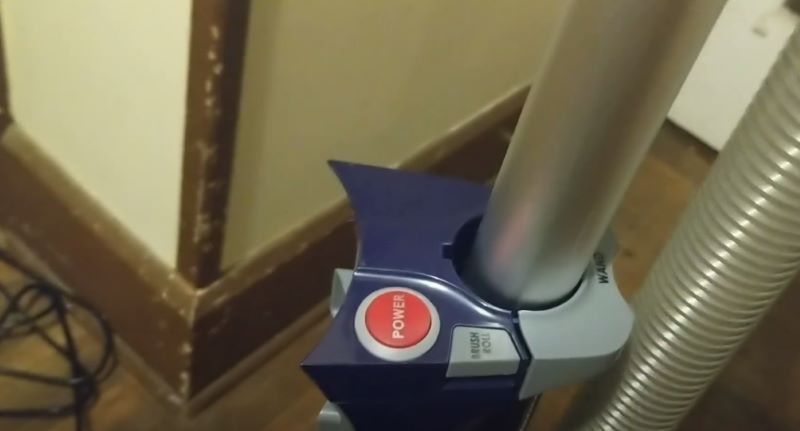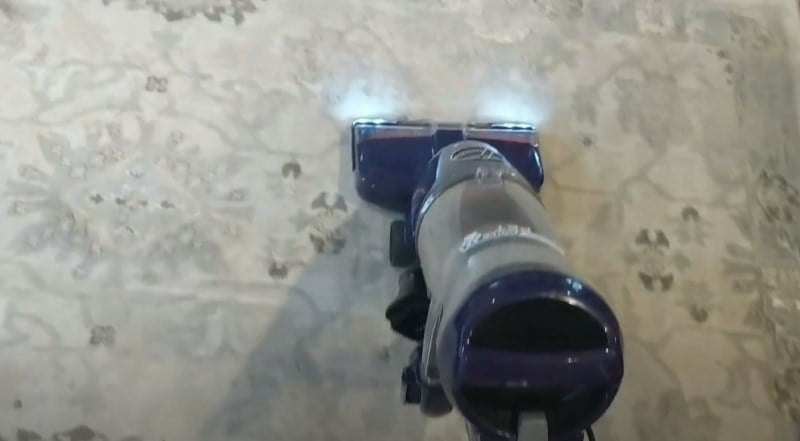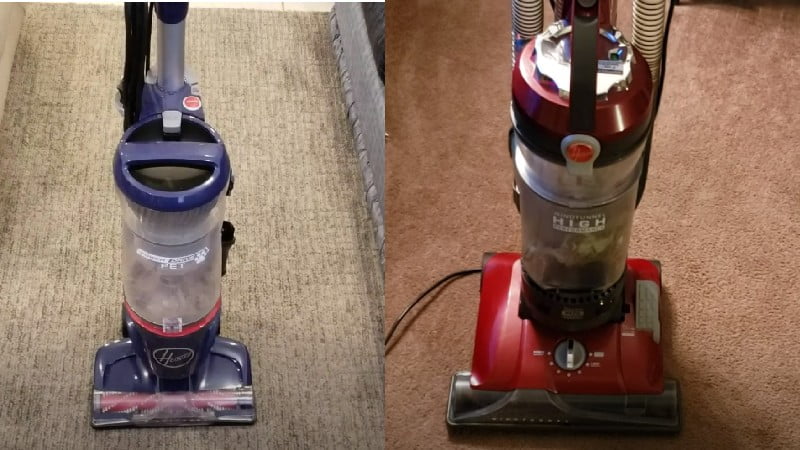Are you in the market for a new vacuum cleaner but can’t seem to decide between the Hoover Power Drive vs Windtunnel 3? With similar price points, consumers typically want to know what sets them apart and which is the best choice for their particular needs. In this blog post, I’ll help you to decide.
The Hoover Power Drive is the perfect vacuum for busy homes. Its advanced brushroll technology can tackle even hard-to-reach spots that other vacuums might miss. The one-touch fingertip controls put all the power of a full-size vacuum into a manageable, lightweight design.
The Hoover Windtunnel 3 is a powerful, lightweight vacuum cleaner that features 3 different suction channels for deep cleaning. The HEPA filter traps 97% of dust and allergens, helping keep your home clean and free of pollutants. However, it still has some limits, causing it to be the runner-up in this competition.
Hoover Power Drive Vs Windtunnel 3: Comparison Chart




Hoover Power Drive Vs Windtunnel 3: Differences
After testing two models, I conclude that Hoover Power Drive wins against Windtunnel 3 with a score of 2-0 and ties once thanks to the powerful cleaning system, its different utilities, and its ease of use.
Cleaning performance
The winner: Hoover Power Drive
Compatible floor type
The Hoover Power Drive seems to have the edge regarding hard floors. Its brush roll feature allows it to easily transition between hard surfaces and carpets, making it a versatile choice for those with a mix of flooring types.
In contrast, the Hoover Windtunnel 3 excels at cleaning carpets of all heights, including shag carpeting. However, its performance on hard floors leaves something to be desired. The “hard floors” setting does not seem to work effectively, and the vacuum can be difficult to move around on hard surfaces.
Carpet cleaning, however, is a different story entirely. Both vacuums work great on carpets of all heights. They provide even suction and good maneuverability to get into all nooks and crannies of thick pile carpets.
Suction power
One thing to note is that both of these vacuums use multi-cyclone technology to improve their suction power. This means that they have multiple cyclones working in tandem to separate out larger particles and debris from the air stream, which helps to prevent clogs and improve the overall efficiency of the vacuum.
Now, let’s look at these vacuums’ specific number of cyclones. The Power Drive has 5 cyclones, while the Windtunnel 3 has a whopping 13 cyclones. This indicates that the latter would have a bit stronger suction than the former. However, remember that the number of cyclones is just one factor that contributes to a vacuum’s suction power.
Next, the Hoover Power Drive boasts a suction control collar that allows you to adjust the suction power to your desired level. I can dial in the amount of suction I need for the task at hand, whether tackling a particularly stubborn stain or simply giving your carpets a quick once-over.
Meanwhile, its rival has a knob that you can rotate to switch the suction from the floor to the accessory/hose. While this allows you to direct the suction to different areas, it’s not quite as adjustable as the Power Drive. Instead of being able to fine-tune the suction power to your liking, you’re limited to switching between two preset levels.
Brush roll

One of the standout features of the PowerDrive is its brush roll on/off switch. This feature allows me to easily toggle the brush roll on or off, depending on the surface I’m vacuuming.
For example, when vacuuming my carpets, I can turn the brush roll on to help agitate the fibers and lift dirt and debris. However, when I need to vacuum my hardwood floors or delicate area rugs, I can simply turn the brush roll off to prevent any potential scratching or damage.
On the other hand, the new version of WindTunnel 3 does not actually have an on/off switch for its brush roll. This means that the brush roll is always on, regardless of the surface I’m vacuuming. While this may not be a problem for some people, it can be a bit of a hassle for those who need to switch between different surfaces frequently.
These machines both offer excellent pet hair-cleaning power. My dog sheds year-round, and I’ve found both vacuums to be the best at getting up all the hair and avoiding clogs or tangles.
Cleaning path
The cleaning path of a vacuum cleaner refers to the width of the nozzle or brush that comes into contact with the floor or surface being cleaned. A wider cleaning path means you can cover more area in a single pass, making cleaning more efficient and faster.
The Hoover PowerDrive has a cleaning path of 12.5 inches, while the Hoover Windtunnel 3 has a cleaning path of 15 inches. This means that the Windtunnel 3 can cover a slightly wider area with each pass, potentially making it a more efficient choice for those with larger homes or those who want to get their cleaning done as quickly as possible.
In general, a higher path is better, but it does come at the expense of extra weight, so the final decision will depend on the needs of the individual.
Maneuverability
Ties!
Weight
In fact, lugging around a heavy vacuum can be tiring, especially if you have to carry it up and down stairs or maneuver it around furniture. With this in mind, it’s worth comparing the weight of the Hoover Power Drive and the Hoover Windtunnel 3 to see which one is more portable and easier to handle.
In this regard, these two models differ slightly. The Power Drive weighs a relatively lightweight 16 pounds, making it easy to maneuver around your home. This is especially helpful if you have a lot of stairs to tackle, as a lighter vacuum will strain your arms and shoulders less.
On the other hand, the Windtunnel 3 weighs in at a slightly heavier 18.1 pounds. While this is still relatively lightweight for a vacuum cleaner, it may be a bit more difficult to carry around than the Power Drive.
Hose & wand

The Hoover Power Drive has a shorter cord length of 30 feet, but its hose length is 9 feet, which is somewhat useful for cleaning around furniture and tight spaces.
In contrast, Windtunnel 3 has a longer hose length of 12 feet and a longer cord length of 40 feet. This gives you more reach, allowing you to cover a greater area. However, the longer cord may be less manageable while navigating around fixed objects like furniture.
However, I appreciate the longer cord length of the Windtunnel 3, as it allows me to reach further without constantly unplugging and moving the vacuum in my large house.
Utilities
The winner: Hoover Power Drive
Dust cup capacity
The dust cup capacity of a vacuum cleaner refers to the amount of dirt, dust, and debris it can hold before emptying. A larger dust cup capacity means you can vacuum for longer before needing to stop and dispose of the collected dirt, thus saving you time.
The Hoover PowerDrive has a dust cup capacity of 1.5 liters, while the Hoover Windtunnel 3 has a capacity of 1.42 liters. While both of these capacities are relatively similar, the former’s slightly larger size may be a small advantage if you have a larger home or tend to vacuum for longer periods of time.
Headlight

One of the key utilities of Power Drive and Windtunnel 3 vacuum cleaners is their headlight construction.
The headlight on the Hoover Power Drive is an LED light known for its brightness and ability to shine on the floor as you are vacuuming. This is a great feature as it allows users to see all the hidden dirt, dust, and fur lurking in corners or under furniture.
It is also energy efficient and has a longer lifespan than traditional incandescent lights, a cost-effective option for users in the long run.
On the other hand, the headlight on the Hoover Windtunnel 3 made some disappointed experiences for me when I tested it. This function is not as illuminating as the LED light on the Power Drive and uses a standard light that is not as effective in all lighting conditions. Furthermore, the headlight has a wide beam and uses the dimmest yellow incandescent bulb, causing it not to be effective in certain lighting conditions.
Height adjustment
The ability to adjust the height of a vacuum is one of the greatest conveniences. Both Hoover PowerDrive and the Hoover WindTunnel 3 have this function. I have had the chance to work with both models and thus provide some insight into how they differ.
Starting with the Hoover PowerDrive, this model has an automatic height adjustment system that can detect varying surfaces and adjust the settings accordingly. This means it can easily transition between low-pile carpets, hard floors, and even furniture upholstery.
The Hoover WindTunnel 3, meanwhile, does have a manual height adjustment. Instead, it must be manually adjusted depending on what surface you try to clean. This can be somewhat inconvenient and time-consuming. Additionally, if it is set at the wrong height, it can result in the vacuum sucking too close to the floor, which can make it difficult to move around.
System check indicator
Another distinction between the Hoover Power Drive and the Hoover Windtunnel 3 is the presence of a system check indicator. The Windtunnel 3 is equipped with this feature, which alerts the user when it’s time to clean the filter. This can be a useful option for those who want to ensure that their vacuum is always operating at its best, as a dirty filter can reduce the appliance’s effectiveness.
On the other hand, the Power Drive does not have this attribute, so it’s up to the user to keep track of when it’s time to clean the filter. While this may not be a deal breaker for everyone, it’s something to consider if you want a vacuum that helps you stay on top of maintenance tasks.
Hoover Power Drive Vs Windtunnel 3: Similarities
Although Power Drive and Windtunnel 3 have several different features, they still come with some interesting things that they share in common. Let’s scroll down and discover!
Filters
The filtration system in a vacuum cleaner is an important factor to consider when buying an upright vacuum cleaner. The Hoover PowerDrive and the Hoover Windtunnel 3 feature HEPA filters designed to capture particles as small as 0.3 microns.
The carbon-based materials help to absorb odors as well as filter out particles. This can be especially helpful for people with pets, as the carbon helps to eliminate pet odors from the air.
Swivel steering
Swivel steering is a feature that allows a vacuum cleaner to move around furniture and other obstacles easily. This can be especially useful when cleaning tight corners or getting into hard-to-reach areas. The Hoover Power Drive and the Windtunnel 3 are equipped with this feature, helping my cleaning task be easier and save my time.
Quick Rundown Of Hoover Power Drive
- THOROUGH CLEANING POWER: The Hoover Power Drive Multi Floor Vacuum has everything you need for a powerful clean. Its advanced filtration technology with an 11-amp motor ensures even the most stubborn debris is effortlessly trapped.
- OPTIMIZED CLEAN: The advanced action brush roll is designed to tackle deep down embedded dirt and reduce hair wrap. Turn the brush roll on for optimal cleaning on carpet and off to prevent scattering of debris on hard floors.
- VERSATILE TOOLS: Clean beyond your floors and target hard-to-reach areas with the included pet turbo tool, dusting brush and crevice tool. Swivel steering and 13-foot cleaning reach provide effortless maneuverability.
- QUALITY FILTRATION: With WindTunnel technology designed to lift and remove embedded dirt and pet hair and a sealed allergen system to capture 99% of dust and allergens, this vacuum gets the job done right.
- NOBODY DOES IT LIKE YOU: For more than 100 years, Hoover has designed powerful, reliable, easy-to-use products that clean your entire home from floor to ceiling. It’s why we’re one of the most trusted brands in America.
Quick Rundown Of Hoover Windtunnel 3
- THOROUGH CLEANING POWER: The Hoover WindTunnel 3 High Performance Pet has everything you need for a powerful clean. Its advanced filtration technology ensures even the most stubborn debris is effortlessly trapped, leaving your floors spotless.
- OPTIMIZED CLEAN: The QuickPass brush roll cleans surface debris 2X faster with fewer passes over the same area. The 40-foot cord provides ample reach for cleaning large rooms without replugging.
- VERSATILE TOOLS: Clean beyond your floors and target multiple surfaces, hard-to-reach areas and pet messes with the included pet turbo tool, pivoting dusting tool, telescoping extension wand and crevice tool.
- QUALITY FILTRATION: With WindTunnel 3 technology to lift and remove surface debris, pet hair and embedded dirt and a HEPA media filter to trap dirt, dust and pollen, this vacuum gets the job done right.
- NOBODY DOES IT LIKE YOU: For more than 100 years, Hoover has designed powerful, reliable, easy-to-use products that clean your entire home from floor to ceiling. It’s why we’re one of the most trusted brands in America.
Product Videos
Related Articles to Hoover Power Drive
Related Articles to Hoover Windtunnel 3
- Shark Navigator Lift Away vs Hoover WindTunnel 3: Which Is The Better Option?
- Hoover WindTunnel 3 vs Bissell CleanView 2486: Good Vacuum Machines For Strong Suction
- Hoover Windtunnel 3 vs Dyson Animal 2: Which One Performs Better For Home Use?
- Hoover Windtunnel 3 vs Shark Navigator Lift-Away Speed: A Head-To-Head Comparision
- Hoover Windtunnel 3 Vs Dyson Ball Animal 3: A Side-By-Side Comparison
- Shark Rotator Professional vs Hoover WindTunnel 3: Which Is Better For Versatility?
- Hoover Windtunnel 3 Vs Shark Navigator: A Full Comparison
- Hoover Windtunnel 3 vs Bissell Pet Hair Eraser: Which One Wins This Battle?
- Hoover WindTunnel 3 vs Bissell Pet Hair Eraser: Which Machine Has The Better Performance?
- Hoover Power Drive vs WindTunnel 3: Which Is The Best For Your Home?
- Hoover WindTunnel 3 vs Shark Navigator: Which Is Excellent Choice For Carpet?
- Hoover Windtunnel 2 vs 3: Why Is The Most Recent Version More Worth Buying?
References:
- Hoover Power Drive: https://hoover.com/products/powerdrive-upright-vacuum
- Hoover Windtunnel 3: https://hoover.com/products/windtunnel-3-high-performance-pet-upright-vacuum-1

Victor K. Giles is a leading consultant and expert in vacuum cleaner technology with over a decade of experience. As a mechanical engineering graduate in the University of Michigan, he specializes in product development, design optimization, and performance analysis. Victor collaborates with manufacturers and educates consumers, making her a sought-after guest speaker at industry events. His work has been featured in renowned publications, and he shares his expertise on his blog, “The Vacuum Teria”. Victor’s passion for cleaner, healthier living spaces drives his to help clients choose the best vacuum solutions for their needs.
